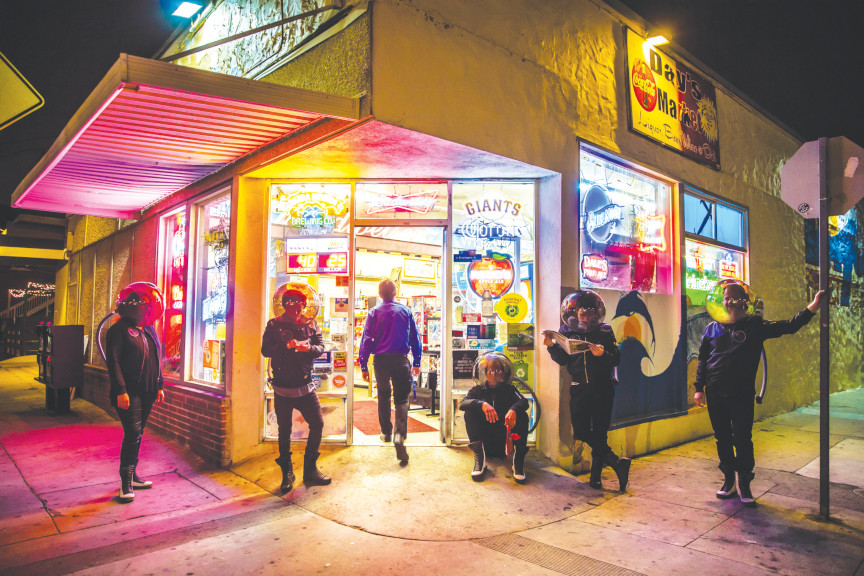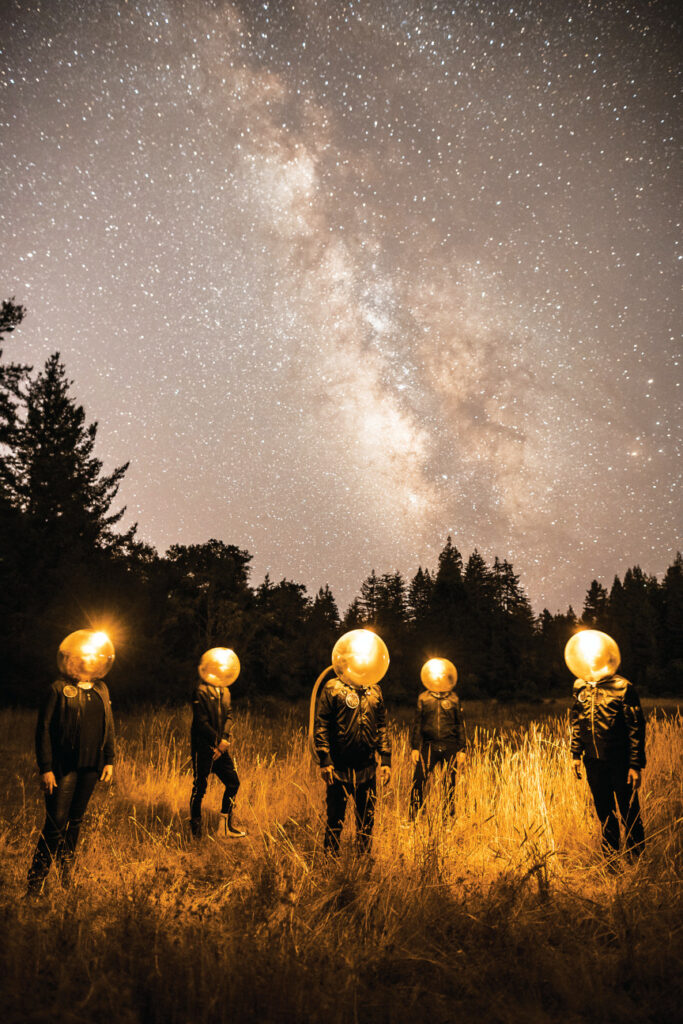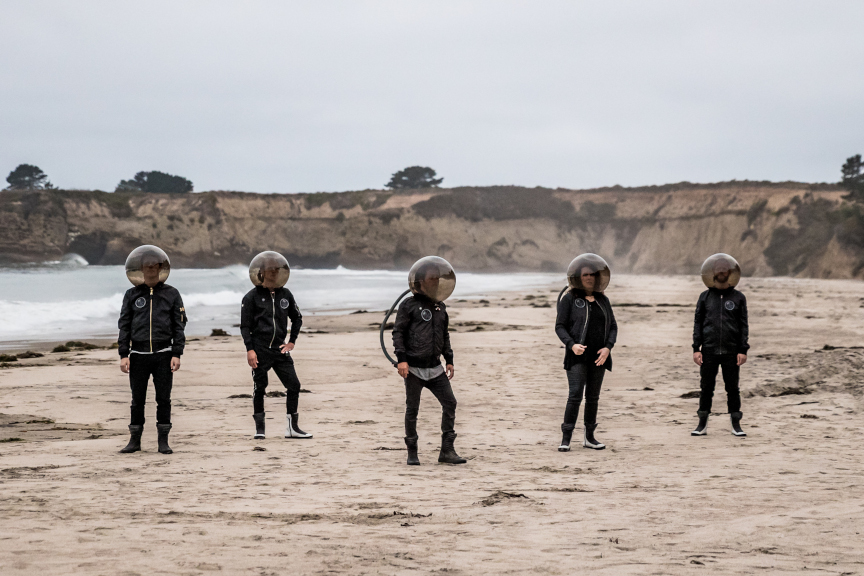How do you describe the music of Sound Tribe Sector 9, aka STS9, to someone who’s never heard it? Sometimes their songs morph into lengthy grooves that enter the jam band zone. At others, the group unleashes unpredictable jazz-fusion tangents informed by Weather Report and Return to Forever. There are elements of trip-hop, acid jazz and electronica—dubbed “livetronica” or “post-rock dance music”—that fuel full-on dance parties among audience members. It’s a soundtrack to a movie that has yet to be made. I can go on. But really, the music that STS9 has spent a quarter of a century making is something you have to hear for yourself—preferably live.
For a quarter of a century, the Georgia natives have been creating something more extensive than a signature sound; they’ve cultivated a one-of-a-kind experience. Thousands of fans follow them nationally and beyond—it’s a phenomenon akin to Phish or even the Grateful Dead. These fans know it’s not just a concert, it’s an all-encompassing intergalactic experience.
STS9’s songs don’t have vocals, but guitarist/keyboardist Hunter Brown, drummer Zach Velmer, bassist Alana Rocklin, keyboardist David Phipps and percussionist Jeffree Lerner are storytellers. Wistful soundscapes intertwine with the vibrant colors and optical illusions provided by masterful lighting designer Tiberius Benson—the quintet considers him their sixth band member.
“When you’re playing live, there’s a microscope when you’re in the studio, there’s a microscope when you’re rehearsing, and you can stop and be like, ‘Oh, look at this or look at that,’” drummer Zach Velmer says. “When performing live, you play through [mistakes], but you learn so much about yourself, the process and the musical conversation you’re having with your brothers and sisters. Then when you’re recording, and you’re under a microscope, it’s all about what the conversation and the music need, so it’s all very dynamic. Each part just plays on itself, so magically.”
One of the keys to the band’s dynamic connection is their ability to get out of their own way, especially during improvisational journeys. Everyone knows when a tune has run its course—the story has been told, and the song is ready to end.
“When we’re in the moment, it’s a feeling we all get,” Velmer says. “It goes beyond using a period just because it’s grammatically correct.”
Bassist Alana Rocklin adds, “I think there’s a flow to it. On Sunday, we did a Wave Spell set, which is a completely improvised set of music for the fans. Wave Spell started in our studio. Instead of just rehearsing and writing songs, we started to feel a need to play whatever was in our hearts and communicate with each other. Wave Spell took on a life of its own through our recordings. We got together and happened to record it, and when we listened to it, we were like, ‘Wow, we should share this.’ Then we started doing it live. In this last set we did, there was this one improvisation, and I didn’t know the end was coming, but Zach played this thing, and because we were listening so intensely, we all just stopped, and that was the end of it. For me, it was one of the best musical moments of the weekend because we were listening so carefully, and I think I looked at him, then I looked at Hunter, and we were all like, ‘Yup, that’s it. It’s done.’ Then, we just laughed.”
“It’s like having this amazing conversation back and forth,” Velmer says. “And you’re feeding off each other’s energy. That’s what it feels like anyway. We just changed the trajectory of the energy in this macro moment. It’s pretty cool.”
Hiding in Sight
For more than 20 years, Sound Tribe Sector 9 has called Santa Cruz home. It’s where the band members live with their families. It’s also where they have their studio. Santa Cruz is their “sacred space.”
“We keep a low profile, but it’s not secretive,” Velmer says. “We love our community. When we’re home, we work in our studio or spend time with our family. Our roots are definitely from the East Coast, but most of our time has been spent here in [Santa Cruz].”
In the summer of 2000, guitarist Hunter Brown drove from his West Athens, Georgia home to Santa Cruz to visit a friend. He dug the area so much that he stayed, and convinced the band to join him. Brown was 22, and at that age life changes like that are pretty easy without families or any real responsibilities. Before hitting it big, the group lived in a dilapidated home in Watsonville.

“I think we’ve always had a difficult time promoting ourselves outside of the music, and the art that comes from the music,” Brown says. “Maybe that’s why nobody really knows we’re here. But Santa Cruz is our favorite place in the world. We’ve been here for almost most of our lives at this point, which is crazy. [Santa Cruz] has been a crucial part of our development as a creative force. We can’t say enough about what this place means or has done for us.”
Throughout the last 20-plus years that Sound Tribe has lived in Santa Cruz, they’ve gone from club act opener to selling out three-night runs at Colorado’s famed Red Rocks Amphitheater, which holds about 10,000. Around the time they released their masterpiece, Artifact, in 2005, Sound Tribe began regularly filling Santa Cruz’s venues, including the Catalyst, the now-defunct Palookaville and headlining the Santa Cruz Civic Center. Santa Cruz is where they started 1320 Records, a niche label for artists—they now have a roster of more than 40—making similar music.
Hello, Alana
Regarding personnel, Sound Tribe hasn’t changed much over the years, which has helped their musical conversations remain consistently fluent. In 2014, when one of the band’s founders, bassist David Murphy left, Alana Rocklin came on board. Rocklin had known and sat in with the group since 2000, so the transition was seamless.
“From the moment we had our first rehearsal, it was an amazing vibe,” Rocklin recalls. “Knowing the music, loving the music, being friends and already loving each other as people made that transition super natural. We’ve just kept it going.”
“It was as effortless as possible,” Velmer adds.
As someone who was initially on the outside, Rocklin can perfectly convey what the band is all about.
“How you are as a human being comes out in the music,” Rocklin says. “Whatever you’re going through in your life, whatever path is happening is reflected in what you’re playing. Coming home after you play and seeing your family and everything that we’ve had to go through, even the pandemic, has been an exciting experience that’s brought us closer and influenced our creativity, and made us want to just get back to the roots of playing music at the most basic level, just like improvising together. One of the most beautiful things about music is that it reflects who you are as a band; that’s something we love about music, so we try to stay true to that.”
Brown adds, “There was no one else that we considered because we knew Alana was who we wanted. It was natural to fall into this new reality together. It’s been incredible. Thank you, Alana.”
For the Fans
Velmer says STS9 has been a “passion project of storytelling since day one. It’s something that has always been a part of us.” And the band’s 2005 opus, Artifact, is a large part of their story, as mentioned earlier.
“Making music in the state of a Tell-a-Vision nation, this album is an ode to change and preservation,” read the record’s original liner notes.
About two weeks ago, just before STS9’s three-night run at Red Rocks, the band released a 43-minute documentary, Artifacts, via YouTube. The short film documents the band’s 20th-anniversary show in 2017 at Red Rocks when they performed Artifact in its entirety, which they had never done. The complexity and the orchestration of the album’s 20-plus songs made it a daunting task—many of the tunes on the record hadn’t even performed live before.
“I think we got to a place where we were finally comfortable performing that album in a way that we felt paid homage to the original creation,” Brown explains. “It just took us a while to get there, and we genuinely wanted to put our time into making it happen. That was a big part of it.”
Velmer adds, “We usually don’t just go out and play an album. We’re telling these stories, and it’s not just a story of an album; it’s a story of the whole existence of STS9, a story that’s beyond the universe we’re all in and compiled of different records. For many of our fans, that was a gateway album that led to consuming more STS9. There are over 20 fucking songs on it, which helped make it such a good show. We knew it was a fan favorite. [Fans] are a huge part of what we do, why we do what we do and how we do what we do. We’ve had this relationship with fans for decades now, which is weird to say, but we’ve learned and grown together, and we’re constantly trying to give them what they want but also surprise them in new and interesting ways.”
“It always comes back to [the fans] in some way,” Brown says. “Each night is a new story. We’re excited to create a new one for Santa Cruz.”
The Quarry Shows
Sound Tribe has had their eye on UCSC’s Quarry Amphitheatre for a long time. The canopy of towering redwoods caressing the former lime quarry’s layout provides natural acoustics similar to Red Rocks, one of Sound Tribe’s favorite venues. Following the theater’s upgrades, it’s even better. Also, it now seats 2,700, making it Santa Cruz’s largest outdoor venue. They even have close friends that have been a part of its restoration.
“There’s been a magical dream manifesting for years, so we’re ecstatic,” Brown says. “We haven’t played in Santa Cruz for a long time, and to have this be where we play? We were patient with where we wanted to play and how we wanted to do it. This is beyond our wildest imagination. It will be a huge family affair, because that’s what Santa Cruz is. We couldn’t be more excited to finally put on the kind of show in Santa Cruz that we’ve wanted to do for so long.”
“It’s really neat to read online conversations from our fans,” Velmer says. “There is this mystery of, ‘I wonder what they’re going to do in Red Rocks?’ and we just did four nights in Atlanta, and now, [fans] are talking about Santa Cruz. For this kind of event, we like when it’s a little bit of a spectacle for fans not to know what it will be. Since we’re always picking up new things, our shows are never the same thing twice. Even with the lighting effects. You get these people conversing. Like, ‘this one’s called this, and they did this, and the rig lifted like they were pushing the sky. Then they were in the sky, and there were clouds.’ The kids are really into what we’re laying down and the creative side. It’s pretty fucking cool, man.”
Like all Sound Tribe shows, no one will know what to expect until the show starts. All that’s learned: “They will be special shows,” Velmer says.
Also, there may be some new music. Brown says they’re about 90% finished with a new record. He can’t give a release date yet, but it’s so close they’ve already begun to debut some of the songs live.
Following both of Sound Tribe’s Quarry performances, there will be afterparties at the Coconut Ballroom featuring Quadraphonic (surround sound) Funktion, the Chambers Project’s psychedelic art and music from Mr. Carmack, Sunsquabi, Machinedrum and several other acts, all curated by STS9. Additionally, there will be local dance performances, floral displays, crystal and mineral displays, local vendors and much more. It’ll basically be a two-day festival between Sound Tribe’s shows and the after-parties.
Give Back
Since Sound Tribe began in the late ’90s, giving back has always been a big part of what they’re about. Spanning back to helping Hurricane Katrina victims, the band has donated hundreds of thousands of dollars and hundreds of hours of volunteering for multiple organizations.
“We’re a community beyond the five of us and the 20 of our crew members, and we try to do the best we can to help as much as we can,” Brown says. “We’ve been lucky to do a lot of great projects, most that people don’t know about, like local things and places that we love and people that have connected with us. It’s something we will continue to do. Over the past few years, we’ve been inspired to work with the Save the Redwoods League, which fought to save Big Basin. We want to continue to help because we’re devastated by what we see—just the changes we’ve witnessed here in California since we’ve been here. We’re always trying to find ways to be engaged and do whatever we can.”

The band’s Just Thanks nonprofit is used as an umbrella to support initiatives and organizations they’re passionate about. Sound Tribe teamed up with Save the Redwoods League recently to purchase a piece of property that used to be a logging camp, but has thousands of giant Sequoias on it. According to Brown, the land will be turned into a park connected to a more extensive park system.
“We’re focused on women’s rights and getting our healthcare rights back,” Rocklin says. “We also did an initiative for the CZU fires, which affected all of us. We constantly remind ourselves to be engaged because it’s just who we are. And we feel fortunate to be able to play music and have this community of people who share in that love of the earth and people.”
The band has collected thousands of pounds of food donations from fans. Bring canned goods to the Quarry shows and get a poster in return. Also, a portion of each ticket sold for the after-parties will go to benefit GrassRoots Alliance.
STS9 plays Friday, Aug. 12 and Saturday, Aug. 13 at 7pm. One night $47.50/$54.50; $77.50/premium; $37.50/students plus fees. 2-day pass $95; $155/premium; $77.50/students plus fees. Quarry Amphitheater at UC Santa Cruz, 1156 High St., Santa Cruz. quarry.ucsc.edu.
Official STS9 After Parties with Mr. Carmack, Sunsquabi, Potions, Machinedrum and more, 11pm at Cocoanut Grove, 400 Beach St., Santa Cruz. $35 plus fees; 2-day pass/$55 plus fees. 21 and over. sts9.com.
STS9 Free Skate Session on Saturday, Aug. 12, is sold out.
Visit sts9.bandcamp.com to listen to and download all music STS9 releases, plus bonus items from their back catalog.














Your dates are wrong. it’s August 4th and 5th.